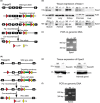Increased microvascular permeability in mice lacking Epac1 (Rapgef3)
- PMID: 27096875
- PMCID: PMC5073050
- DOI: 10.1111/apha.12697
Increased microvascular permeability in mice lacking Epac1 (Rapgef3)
Abstract
Aim: Maintenance of the blood and extracellular volume requires tight control of endothelial macromolecule permeability, which is regulated by cAMP signalling. This study probes the role of the cAMP mediators rap guanine nucleotide exchange factor 3 and 4 (Epac1 and Epac2) for in vivo control of microvascular macromolecule permeability under basal conditions.
Methods: Epac1-/- and Epac2-/- C57BL/6J mice were produced and compared with wild-type mice for transvascular flux of radio-labelled albumin in skin, adipose tissue, intestine, heart and skeletal muscle. The transvascular leakage was also studied by dynamic contrast-enhanced magnetic resonance imaging (DCE-MRI) using the MRI contrast agent Gadomer-17 as probe.
Results: Epac1-/- mice had constitutively increased transvascular macromolecule transport, indicating Epac1-dependent restriction of baseline permeability. In addition, Epac1-/- mice showed little or no enhancement of vascular permeability in response to atrial natriuretic peptide (ANP), whether probed with labelled albumin or Gadomer-17. Epac2-/- and wild-type mice had similar basal and ANP-stimulated clearances. Ultrastructure analysis revealed that Epac1-/- microvascular interendothelial junctions had constitutively less junctional complex.
Conclusion: Epac1 exerts a tonic inhibition of in vivo basal microvascular permeability. The loss of this tonic action increases baseline permeability, presumably by reducing the interendothelial permeability resistance. Part of the action of ANP to increase permeability in wild-type microvessels may involve inhibition of the basal Epac1-dependent activity.
Keywords: Epac deletion (mouse); Rapgef; atrial natriuretic peptide; cAMP; endothelial junction; microvascular permeability (in vivo).
© 2016 The Authors. Acta Physiologica published by John Wiley & Sons Ltd on behalf of Scandinavian Physiological Society.
Figures






Comment in
-
Epac1 - a tonic stabilizer of the endothelial barrier.Acta Physiol (Oxf). 2017 Feb;219(2):339-340. doi: 10.1111/apha.12738. Epub 2016 Jul 15. Acta Physiol (Oxf). 2017. PMID: 27332548 No abstract available.
Similar articles
-
Epac1-/- mice have elevated baseline permeability and do not respond to histamine as measured with dynamic contrast-enhanced magnetic resonance imaging with contrast agents of different molecular weights.Acta Physiol (Oxf). 2019 Mar;225(3):e13199. doi: 10.1111/apha.13199. Epub 2018 Nov 2. Acta Physiol (Oxf). 2019. PMID: 30300965 Free PMC article.
-
Atrial natriuretic peptide modulation of albumin clearance and contrast agent permeability in mouse skeletal muscle and skin: role in regulation of plasma volume.J Physiol. 2010 Jan 15;588(Pt 2):325-39. doi: 10.1113/jphysiol.2009.180463. Epub 2009 Nov 30. J Physiol. 2010. PMID: 19948658 Free PMC article.
-
Deficiency of exchange protein directly activated by cAMP (EPAC)-1 in mice augments glucose intolerance, inflammation, and gut dysbiosis associated with Western diet.Microbiome. 2022 Nov 4;10(1):187. doi: 10.1186/s40168-022-01366-0. Microbiome. 2022. PMID: 36329549 Free PMC article.
-
Interaction of Epac with Non-canonical Cyclic Nucleotides.Handb Exp Pharmacol. 2017;238:135-147. doi: 10.1007/164_2015_37. Handb Exp Pharmacol. 2017. PMID: 27900608 Review.
-
Epac: defining a new mechanism for cAMP action.Annu Rev Pharmacol Toxicol. 2010;50:355-75. doi: 10.1146/annurev.pharmtox.010909.105714. Annu Rev Pharmacol Toxicol. 2010. PMID: 20055708 Review.
Cited by
-
Exchange protein directly activated by cAMP plays a critical role in regulation of vascular fibrinolysis.Life Sci. 2019 Mar 15;221:1-12. doi: 10.1016/j.lfs.2019.02.014. Epub 2019 Feb 7. Life Sci. 2019. PMID: 30738042 Free PMC article.
-
Exchange Protein Directly Activated by cAMP Modulates Ebola Virus Uptake into Vascular Endothelial Cells.Viruses. 2018 Oct 16;10(10):563. doi: 10.3390/v10100563. Viruses. 2018. PMID: 30332733 Free PMC article.
-
A Membrane Permeable Prodrug of S223 for Selective Epac2 Activation in Living Cells.Cells. 2019 Dec 6;8(12):1589. doi: 10.3390/cells8121589. Cells. 2019. PMID: 31817822 Free PMC article.
-
Epac1-deficient mice have bleeding phenotype and thrombocytes with decreased GPIbβ expression.Sci Rep. 2017 Aug 18;7(1):8725. doi: 10.1038/s41598-017-08975-y. Sci Rep. 2017. PMID: 28821815 Free PMC article.
-
Intracellular receptor EPAC regulates von Willebrand factor secretion from endothelial cells in a PI3K-/eNOS-dependent manner during inflammation.J Biol Chem. 2021 Nov;297(5):101315. doi: 10.1016/j.jbc.2021.101315. Epub 2021 Oct 20. J Biol Chem. 2021. PMID: 34678311 Free PMC article.
References
-
- Christensen, A.E. , Selheim, F. , de Rooij, J. , Dremier, S. , Schwede, F. , Dao, K.K. , Martinez, A. , Maenhaut, C. , Bos, J.L. , Genieser, H.G. & Doskeland, S.O. 2003. cAMP analog mapping of Epac1 and cAMP kinase. Discriminating analogs demonstrate that Epac and cAMP kinase act synergistically to promote PC‐12 cell neurite extension. J Biol Chem 278, 35394–35402. - PubMed
-
- Cullere, X. , Shaw, S.K. , Andersson, L. , Hirahashi, J. , Luscinskas, F.W. & Mayadas, T.N. 2005. Regulation of vascular endothelial barrier function by Epac, a cAMP‐activated exchange factor for Rap GTPase. Blood 105, 1950–1955. - PubMed
Publication types
MeSH terms
Substances
Grants and funding
LinkOut - more resources
Full Text Sources
Other Literature Sources
Molecular Biology Databases

